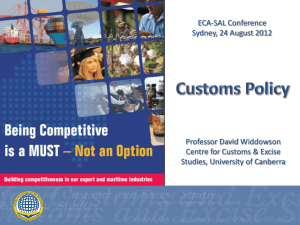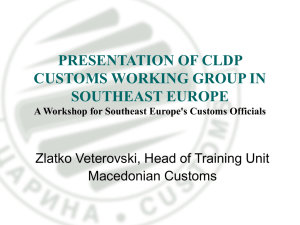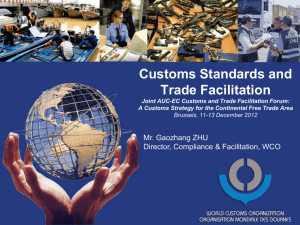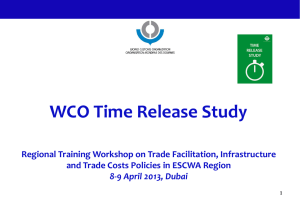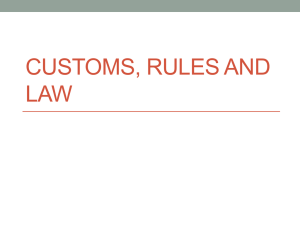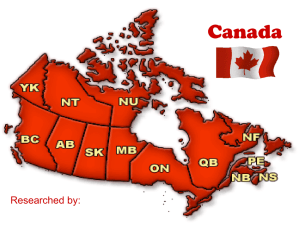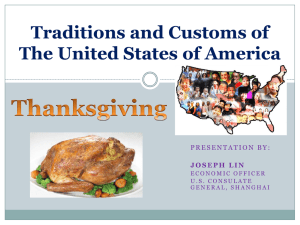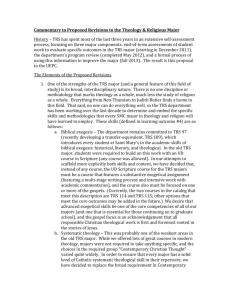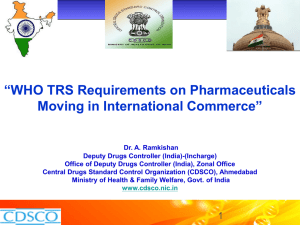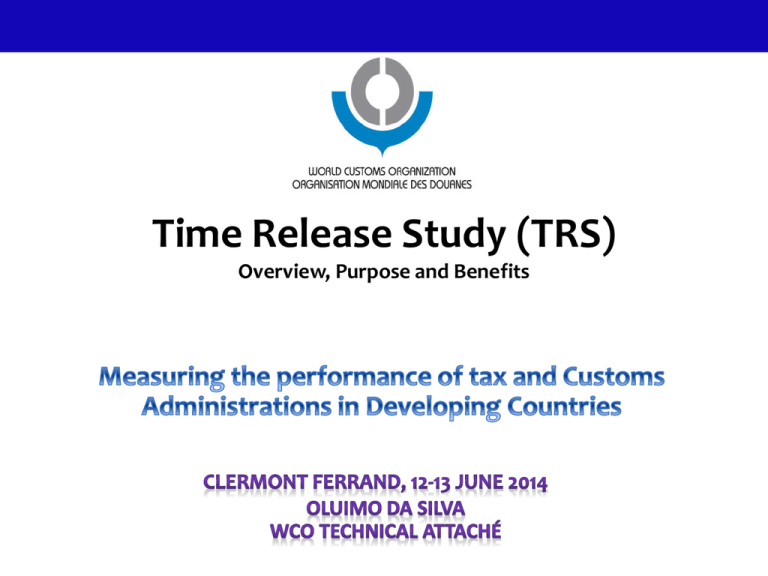
Time Release Study (TRS)
Overview, Purpose and Benefits
1
What is the WCO?
The WCO has 179 Members across the globe that collectively process
approximately 98% of world trade.
3 Main Strengths of WCO
Capability and responsibility for
global standard setting for Customs
Standard Setting
Network of accredited
experts from Customs
Administrations
Cooperation with other
international organizations
and other agencies
Capacity Building /
Technical Assistance
delivery
2
Standard, tools and instruments!
WCO Standards Evolution
(not exhaustive)
Data Model
Version 3.0 (Guide) (2010)
HS Convention (2012)
Data Model
Version 2.0 (Guide) (2005)
Resolution on UCR and
Implementation Guide (2004)
HS Convention (2007)
Data Model
Version 1.1 (Guide) (2003)
Data Model
Version 1.0 (Guide) (2002)
HS Convention (1996/2002)
HS Convention (1987)
AEO Guidelines (2006)
Diagnostic Framework*
(Guide) (2003)
ISCM Guidelines (2005)
ICT Guidelines (2004)
Immediate Release Guidelines (2003)
Risk Management
Guide (2003)
Recommendation on
the use of WWW (1999)
Revised Kyoto Convention and its Guidelines(1999)
Recommendation on
Pre-entry
classification (1996)
Benchmarking Manual
(Guide) (2003)
Guidelines for Express Consignments
Clearance (1993)
Istanbul Convention (1990)
Kyoto Convention (1973)
ATA Convention (1963)
Convention establishing CCC (1950)
*Diagnostic Framework is a living document and contains
entire Customs themes, including the TF
What is Time Release Study Guide?
Measure the average time between the arrival of the
goods and their release
Measure the time required for each intervening event
between the arrival and release of the goods
Measure the time required for Customs clearance of
goods
– By region
– By individual customs office
– By type of traffic
5
What is Time Release Study Guide?
Performance measurement Guide for the WCO Members
Diagnostic initiative that allows improvement in Customs
and Stakeholders’ methodologies or activities with regard
to operational procedures related to the flow of cargo.
TRS is a unique tool and method for measuring the actual
time required from arrival of goods to its release.
5
Objectives
Identifying bottlenecks processes affecting
customs release
Assessing new procedures, operations, etc.
Establishing baseline TF performance
measurement
Identifying opportunities for TF improvement
Estimating the country’s approximate position as
a benchmarking tool
6
Reasons for using the TRS Guide
Huge increase in cross border trading as a result of
globalization, customs role in trade facilitation (TF)
becomes more prominent.
Expediting the movement, clearance & release of goods
have been a major desire for many Customs in the 21st
Century
Just-in-time delivery of goods have become important for
business and brings significant benefits to all parties
involved in the supply chain
7
Reasons for using the TRS Guide
Some initiatives to assess the efficiency and effectiveness
of Customs and OGAs procedures are based on perception
e.g. The World Bank Doing Business Report
The new Agreement on Trade Facilitation
The Delays in the release of goods are very often attributed
to Customs since they are one of the more visible agency at
the border.
8
Example?
Bill of lading
Terminal permission
License
Customs
Declaration
Fees payment
What and how is the Solution?
To use of the WCO TRS package:
-The TRS Guide
-The Internet Software for the TRS
-The User Manual for TRS Software
By the applying the methodology outlined in the Guide
which covers 3 phased;
-I-Phase
-II-Phase
-III-Phase
10
Three Phases
11
Questionnaire Sea form
12
Example of a Report
Final Report
• Objectives
• Scope
• Methodology
• Analysis
• Conclusion
• Recommendations
(Action Plan)
13
Some characteristics of the TRS
Unique tools, but applies to multiply mode of transport
and to several type of procedures such as import, transit
and export goods etc
Cutting Cross tool, not based on perception
Recognized to be a Cycle leading to continues
improvement
14
Image of possible scope of the TRS
Cargo Flow from Arrival to Release of Goods
OGAs’
Intervention (if any)
15
TRS Implementation by Members
Asia Pacific
Australia
Bhutan
Brunei
China
Fiji
India
Indonesia
Japan
Korea
Lao PDR
Malaysia
Mongolia
New Zealand
PNG
Philippines
Singapore
Thailand
Viet Nam
Africa
Ethiopia
Kenya
Malawi
Mozambique
Nigeria
Rwanda
Tanzania
Swaziland
Uganda
Zambia
Other
Jamaica
Jordan
Peri
Poland
Sweden
Uzbekistan
Benefits of TRS
Procedures, Processes & Legislation
Diagnose the efficiency of specific customs
procedures
Take measures to improve compliance or
enforcement
Simplify and harmonize customs procedures
Automate Customs processes
Draft / modify relevant Customs legislation
17
Benefits of TRS
Organization
Reallocate staff and resources for optimal
utilization
Initiate organizational reform
Support requests for human, financial and technical
resources
Address anti-corruption measures
Train staff
18
Benefits of TRS
Performance Measurement & PR
Use as a quality assurance mechanism
Benchmark trade facilitation performance levels
Improve customs transparency and promote PR
Use with OGAs & trading community for further
enhancement of TF measures
19
Reduction of the Time, e.g. Japan
Sea Cargoes
1991
47.6
1992
45.2
1993
94.5
35.4
1998
35.1
2001
63.7
10.2
5.6
46.0
4.9
37.8
2004
26.0
36.8
2006
26.8
33.7
3.3
2009
26.3
33
3.1
2012
27
31.2
2.6
20
13.1
49.5
31.1
0
19.8
84.9
39.4
1996
26.1
40
Arrival - Warehousing
7.0
Days
4.3
60
2.5
Days
80
100
Warehousing - Declaration
120
140
160
Declaration - Permission
(Hours)
180
Benefits of TRS
Overall benefits
Win & Win situation, as it enhances C to B and C to G
Reduces the supply chain time, from arrival to
release cargo
Reduces transaction cost for businesses
Promotes investment in a broader manner
Contributes to economic development of countries,
and prosperity
21
Thank you for
your kind attention.
For more information,
please visit:
www.wcoomd.org
« Copyright © 2013 World Customs
Organization. All rights reserved.
Requests and inquiries concerning
translation, reproduction and adaptation
rights should be addressed to
copyright@wcoomd.org ».

